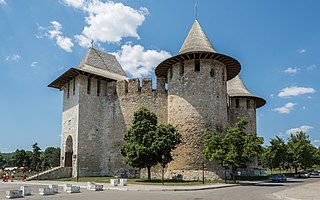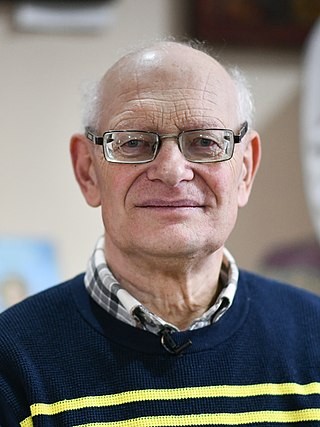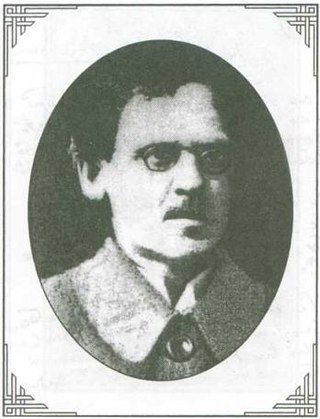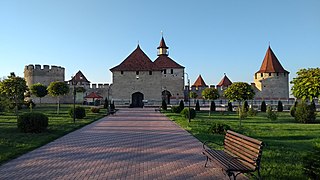
Bessarabia is a historical region in Eastern Europe, bounded by the Dniester river on the east and the Prut river on the west. About two thirds of Bessarabia lies within modern-day Moldova, with the Budjak region covering the southern coastal region and part of the Ukrainian Chernivtsi Oblast covering a small area in the north.

Soroca is a city and municipality in northern Moldova, situated on the Dniester River about 160 km (99 mi) north of Chișinău. It is the administrative center of the Soroca District.

Roman I was Voivode of Moldavia from December 1391 to March 1394. He was the second son of Costea and Margareta Muşata the daughter of the first ruler of Moldavia, Bogdan I and the founder Muşatin family.

Trajan's Wall is the name used for several linear earthen fortifications found across Eastern Europe, Moldova, Romania, and Ukraine. Contrary to the name and popular belief, evidence shows the ramparts were likely not built under the reign of Trajan, but later, in the period of Late Antiquity. The association with the Roman Emperor Trajan may be a recent scholarly invention of the national awakening movement of the 19th century, linking the emerging identity of the modern Romanian people to the glory of Classical Rome. Documents from medieval Moldavia referred to the earthworks as Troian, likely in reference to a mythological hero in the Romanian and Slavic folklore. The other major earthen fortification in Romania, Brazda lui Novac, is also named after a mythological hero.

The Khotyn Fortress is a fortification complex located on the right bank of the Dniester River in Khotyn, Chernivtsi Oblast (province) of southwestern Ukraine. It lies within the historical region of northern Bukovina, a Romanian territory occupied in 1940 by the Soviet Union following the Molotov–Ribbentrop Pact. The fortress is located near another famous defensive structure, the Kamianets-Podilskyi Castle. Construction of the current stone Khotyn Fortress began in 1375. The fortress underwent significant improvements in the 1380s and in the 1460s under the Moldavian princes Alexander the Good and Stephen the Great.

Neamț Citadel is a medieval fortress located in north-eastern part of Romania, near Târgu Neamț, Neamț County. It was built in 14th century Moldavia during Petru I of Moldavia's reign and expanded in the 15th century. The citadel played a key role in Stephen III of Moldavia's defense system, along with Suceava, Hotin, Soroca, Orhei, Tighina, Chilia and Cetatea Albă.

The Alley of Classics is a sculptural complex located in the Stephen the Great Park in Central Chișinău, Moldova.

Mingir is a commune in Hîncești District, Moldova. It is composed of two villages, Mingir and Semionovca. During the 1990s, the poor Mingir village became a central source to an international organ trafficking business.

Gheorghe E. Cojocaru is a historian from the Republic of Moldova.
Grigore Turcuman was a Bessarabian Romanian politician. As a member of Sfatul Țării, he voted the Union of Bessarabia with the Kingdom of Romania on 27 March 1918.
Anton Crihan was a Bessarabian politician, lawyer, author, economist, professor and journalist. He was a member of Sfatul Țării (1917), adviser to the Secretary of State for Agriculture in the General Directorate of the Republic of Moldova (1917), deputy in the Parliament of Romania, adviser to the Secretary of State at the Ministry of Agriculture and Domains (1932–1933), professor at the Polytechnic University of Iasi and at the Faculty of Agronomy in Chișinău (1934–1940).
Sergiu Musteață is a historian from the Republic of Moldova and Dean of History and Geography Faculty, "Ion Creangă" State Pedagogical University.

Nicolae Bulat was a Moldovan historian and director of Soroca Museum of History and Ethnography.

Iustin Ștefan Frățiman, also known as Frațman, Froțman, or Frățimanu, was a historian, educator, librarian and political figure from Bessarabia, active in the Russian Empire and the Kingdom of Romania. After receiving a classical education, he worked for various seminaries of the Russian Orthodox Church, moving as far north as Olonets. Frățiman had settled in Soroca by the time of World War I, becoming a champion of Romanian nationalism. This resulted in his being exiled to Central Asia until 1917. Allowed back home after the liberal February Revolution, he resumed his activism, openly campaigning for the national rights of Romanians east of Bessarabia. He was afterwards one of the educators tasked with institutional Romanianization by the Moldavian Democratic Republic.

Râșnov Fortress is a medieval Fliehburg-type fortress, which offered refuge for townspeople and villagers from the area in times of war. It is situated in Râșnov, Brașov County, not far from Brașov.

The Romanian military intervention in Bessarabia took place between 19 January and 8 March 1918, as part of the broader Allied intervention in the Russian Civil War. It pitted the Kingdom of Romania, Russian Republic, Ukrainian People's Republic and anti-Bolshevik factions of the Moldavian Democratic Republic on one side, against the Bolshevik controlled Rumcherod and Odessa Soviet Republic, as well as pro-Bolshevik factions within the Moldavian DR. The intervention began when the Romanian army and its allies crossed into Bessarabia and launched an attack on Chișinău and Ungheni, capturing the latter.
The Moldovan resistance during World War II opposed Axis-aligned Romania and Nazi Germany, as part of the larger Soviet partisan movement. The Moldavian Soviet Socialist Republic (MSSR), presently Moldova, had been created in August 1940 after a Soviet annexation, and liberated by Romania during Operation Barbarossa. Moldovan resistance straddled across a new administrative border: in 1941–1944, Bessarabia was reincorporated within Romania as a semi-autonomous governorate, while areas across the Dnister were administered into a separate Transnistria Governorate. Shortly after the German–Romanian invasion of June–July 1941, the Communist Party of Moldavia (PCM) ordered the creation of a partisan network. The order was largely ineffective in creating an organized movement due to the rapid disintegration of Soviet territorial structures in Bessarabia. Some early organizers opted to abandon their posts, and Soviet attempts to infiltrate experienced partisans across the front line were often annihilated by the Special Intelligence Service. Nevertheless, partisan formations were still able to stage large-scale attacks on the Romanian infrastructure, at Bender and elsewhere. While Romanian documents identified categories of locals influenced by communist ideas as a passive component of the resistance, various modern commentators point to the overall unpopularity of communism in Bessarabia as accounting for the movement's marginality.

The Bendery Fortress is a 15th-century fortress on the right bank of the Dniester River in Bender, Moldova, built from earth and wood during the reign of Prince Stephen the Great. In 1538 it was conquered by the Turkish sultan Suleiman the Magnificent, who ordered it to be rebuilt in stone and enlarged.

The Bessarabia Governorate was an administrative unit of Romania during World War II.
Filimon Ivanovici Săteanu or Săteanul was a Moldovan poet and victim of the Great Purge. Though an ethnic Romanian from Bessarabia, he was active and published in the Soviet Union's Moldavian Autonomous Republic (MASSR). Known publicly as a committed communist, Săteanu allegedly supported the notion that Moldavians and Romanians are the same people, and was singled out as a Romanian nationalist. This resulted in his execution by the NKVD.

























